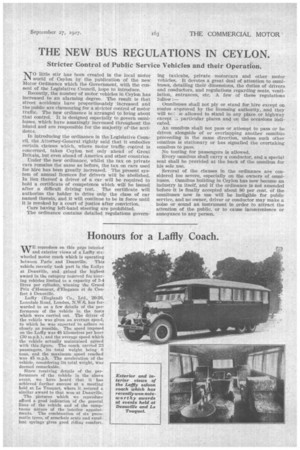THE NEW BUS REGULATIONS IN CEYLON.
Page 57

If you've noticed an error in this article please click here to report it so we can fix it.
Stricter Control of Public Service Vehicles and their Operation.
NO little stir has been created in the local niotor world of Ceylon by the publication of the new Motor Ordinance which the Government, with the consent of the Legislative Council, hope to introduce.
Recently, the number of motor vehicles in Ceylon has increased to an alarming degree. The result is that street accidents have proportionately increased and the public are clamouring for a stricter control of motor traffic. The new ordinance is arranged to bring about that control. It is designed especially to govern omnibuses, which have amazingly increased throughout the island and are responsible for the majority of the accidents.
In introducing the ordinance in the Legislative Council, the Attorney-General rightly said that it embodies certain clauses which, where motor traffic control is concerned, takes Ceylon not only ahead of Great Britain, but even ahead of America and other countries.
Under the new ordinance, whilst the tax on private cars remains the same as before, the tax on ears used for hire has been greatly increased. The present system of annual licences for drivers will be abolished. In lieu thereof a driver of a car will be required to hold a certificate of competence which will be issued after a difficult driving test. The certificate will authorize the holder to drive only the class of car named therein, and it will continue to be in force until it is revoked by a court of justice after conviction.
Cars having left-hand steering are prohibited.
The ordinance contains detailed regulations govern
ing taxicabs, private motorcars and other motor vehicles. It devotes a great deal of attention to omnibuses, detailing their dimensions, the duties of drivers and conductors, and regulations regarding seats, ventilation, entrances, etc. A few of these regulations follow:—
Omnibuses shall not ply or stand for hire except on routes auproved by the licensing authority, and they will no :).e allowed to stand in any place or highway except particular places and on the occasions indicated.
An omnibus shall not pass or attempt to pass or be driven alongside of or overlapping another omnibus proceeding in the same direction, unless such other omnibus is stationary or has signalled the overtaking omnibus to pass.
No touting for passengers is allowed.
Every omnibus shall carry a conductor, and a special seat shall be provided at the back of the omnibus for his sole use.
Several of the clauses in the ordinance are considered too severe, especially on the owners of omnibuses. Omnibus building in Ceylon has now become an industry in itself, and if the ordinance is not amended before it is finally accepted about 80 per cent, of the omnibuses now in use will be ineligible for public service, and no owner, driver or conductor may make a noise or sound an instrument in order to attract the attention of the public, or to cause inconvenience or annoyance to any person.












































































































